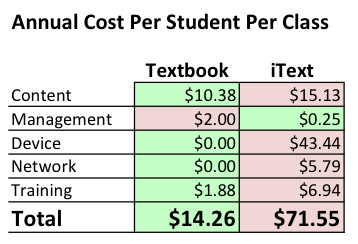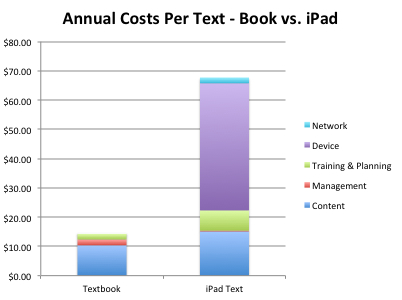From a Publisher’s perspective Apple’s iPad textbook initiative is a decent 1.0 release with promise. I’ve had a few weeks to play with iBooks Author and iBooks2 and discuss them with colleagues. I’ll write about the many positives in future posts.
But there is a worm in this apple. All the sweet promises Apple is making are going to slam headfirst into the funding issue. It will cost a school 552% more to implement iPad textbooks than it does to deploy books. That ain’t happening in THIS economy. The press reports I’ve seen have completely missed this because Apple “hand waved” their way around it.
Update – A follow on post discussion of reader responses is here.
Follow me down into the details where the devil resides….
THINGS DON’T ADD UP (or they do and it is a lot of money…)
There are five components to the cost and we’ll examine each.

Apple is targeting High Schools so this is the baseline we’ll use. The average high school has 752 students, 43 teachers, and a total budget of $7.7 million (data sourced from NCES).*1
The right way to compare the cost of a textbook and an iText is on an annualized basis per student – this provides the fairest apples to apples (ahem) evaluation. I’ve amortized the various components based on their usual lifespan. I’ve tried to stick to per student per class pricing – this is the most scalable unit of measurement for schools of all sizes.*2
This analysis looks at the economics from a school’s perspective, in the future I’ll address how this new model affects publishers’ business model.
If you want the spreadsheet so you can tweak the variables email me at info@headwaystrategies.com for a copy.
CONTENT – Advantage Print
At the heart of Apple’s messaging is the idea that at $14.99 an iText is significantly less expensive than a $60 textbook. The nicest way I can think of to characterize this promise is that it is a follicly challenged prevarication.*3 Apple should know better.
When a school buys a $60 textbook today they use it for an average of 5-7 years for a per student cost of about $10. When a school buys an Apple iText it costs them $14.99 per student – per year.
You also have to factor in the teacher edition – I used $200 for a print version and $49.99 for a digital version (this is frequently the most expensive piece to produce in print because of the low number of units created). For large deals publishers often provide a free TE for every 30 student editions purchased – but I’ve handicapped the print by including it at full cost.
The annual content cost per student per class comes out to $10.38 per student for a printed textbook and $15.24 for the digital. The digital version is 34% more expensive.*4
Right out the gate using a true annualized cost Apple’s claims fall apart.
 MANAGEMENT – Advantage Digital
MANAGEMENT – Advantage Digital
In both cases there is some management involved in getting the right materials to the right student. We’ll call it $2 a year for a textbook – districts have to catalog it, repair it, and store it somewhere over the summer. On the digital side I used $0.25 for getting the right download code to the right student, this also involves cataloging and has an annual purchase cycle (vs. the 1 time buy for the book). No storage or repair gives digital a huge advantage.
A big plus to bytes vs. dead trees on this score.
DEVICE – Advantage Print
Apple’s price comparison completely ignored the fact that consuming the digital content requires an iPad that the district is obligated to provide. In private schools and Universities the institution can mandate that students bring their own device (BYOD). That doesn’t work in public K12 schools. If the content requires an iPad then the school also has to provide it to make sure there is equitable educational opportunity.
There is a huge upfront cost to doing this and the iPads will also need to be replaced on a regular basis (every 4-5 years). iPads also need service contracts and insurance – teenagers are not known for handling their things particularly well.
I used current pricing from Apple for the low end Wi-Fi only iPad, AppleCare service contract, and an insurance policy from a third party provider (damage, theft, etc.). The annual cost per device is $206, or $163,300 per year for the average high school. Assuming 5 courses this comes out to $43.44 per class per student.
Books are their own device so there is $0 annual additional cost. The device is a pure add-on cost from the district’s perspective.
Yes – because of Moore’s Law these costs will fall with time. But no matter how low they go they will always be incremental over the cost of a book.
 NETWORK – Advantage Print
NETWORK – Advantage Print
Putting an additional 750 devices on a wireless network isn’t a trivial exercise. A school isn’t like an office environment where usage by any one user is fairly random over the course of the day. A school runs on a bell schedule so most of those 750 devices are likely to be hitting the network at the same time. When you are relying on the iPad no network equals no learning – which isn’t acceptable.
A cheap $50 wireless access point from Best Buy isn’t going to hack it in this environment. Schools will need industrial grade access points with load balancing and several other features to handle the spiky volume. These typically run in the $500 range. A school will need about 30 of these to support 800 users (don’t forget the teachers).
I’ve assumed for the purposes of this exercise that the school is fully wired. If a school has to lay cable, punch through walls, etc. that would be on top of my estimates. But I think it safe to say that most high schools have been through that upgrade by now.
In addition to the access points an additional 4-5 T1 lines will be needed to handle the network volume. I’ve assumed 4 lines at an eRate cost of $400 a month/line. This is an informed guess on the bandwidth needs.
All-in the network infrastructure will run about $21,750 a year per school. or $6.94 per student per class. Like the device this is purely incremental on the digital side of the ledger.
I consider this estimate to be very conservative – an actual schools’ costs could be dramatically higher depending on the quality of their existing IT infrastructure.
TRAINING – Advantage Print
Teacher training is a bit complicated, but it bakes down into up-front training and annual tune-ups.
Textbooks are a known entity, schools and publishers have developed pretty efficient mechanisms to getting teachers oriented to a new textbook. The iText adds a need to train teachers on how to incorporate the devices into their classroom practice.
On an annual basis once a teacher has incorporated a textbook into their lesson plans there is very little fine tuning until the book changes. With a digital text the content should update every year requiring tweaks and updates to the teacher’s plans. Current content is a huge advantage for the digital text and one of the prime reasons to consider moving in this direction. But from a budget standpoint it comes with a real cost that can’t be ignored.
I peg the amortized cost of teacher training for a textbook at $1.88 per student per class and the digital text at $6.94. Most of the difference is attributable to the annual updates.
PUTTING IT ALL TOGETHER
At every level except management the iPad texts are more expensive. The single biggest contributor to the imbalance is the iPad itself, followed by the network. There will be widespread trials over the next couple of years, some of them quite large and visible. But the mass of the market won’t move until there is clear evidence of efficacy and the budget situation for schools improves.

There is a case to be made that an interactive digital experience is a more powerful learning tool and thus worth more, but Apple didn’t really make that claim. We are likely to hear lots of bleating about engagement and how much the kids love to work with these devices. To which educators should respond with “great – where is the objective data on improved outcomes?” There are enough schools deploying the devices now that a preliminary study or two ought to be available. As a long term advocate of ed-tech I hope the data supports the thesis, but until we see the proof, claims along these lines ought to be regarded as aspirational marketing.
If the political will was there on the national level an additional $6.5 billion per year would do the trick. That would be stimulating.
FINAL RANT
One more thing. The next time some ignorant bloviator refers to “outrageously priced textbooks” remind them that at 6 cents per day a textbook is about as efficient as you are going to get for high quality, well designed, instructionally sound, standards aligned, and globally permissioned materials.
Update – A follow on post discussion of reader responses is here.
_______________________
*1 Wherever possible I’ve used data from a reputable source and noted that in the spreadsheet. I did have to make a few assumptions (e.g. the lifespan of an iPad). If you want to play with the spreadsheet yourself to tweak the variables please email me at info@headwaystrategies.com and I’ll send you a copy.
*2 It is complicated because some of the costs are per student (the text), some per teacher (training), and some per school (networks). Breaking these back down to a per student basis is the only common denominator that works well.
*3 Bald lie
*4 I didn’t factor in student mobility, but since the iText is registered to the student’s Apple ID not the school’s once a student uses a download code it expires. If that student leaves during the school year the district can’t simply pass the iText along to the new student the way they would with a book. I think Apple and the publishers will come up with a solution for this so I didn’t think it was fair to include it – but it is a real issue as things stand right now.
 The Education Business Blog
The Education Business Blog

